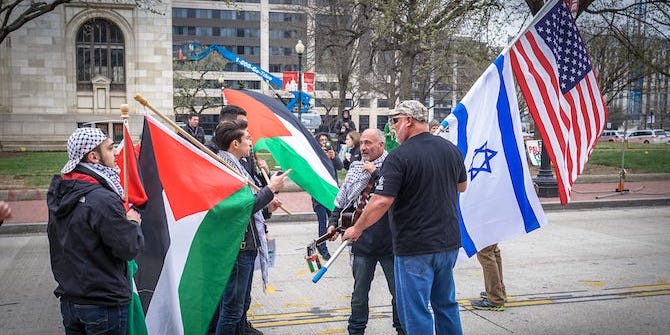by Mustafa Fatih Yavuz

© Peter Biro/EU/ECHO.
In Area C, the 60 percent of the West Bank to which the Oslo Accords afford Israel exclusive control, the Israeli Civil Administration’s administrative violence – deployed under several guises, including that of planning and construction – is the main cause of Palestinian internal displacement. According to the Internal Displacement Monitoring Centre, Palestinian displacement primarily results from less visible and cumulative pressures that reduce Palestinian access to services and resources, and limit their ability to maintain their existence in their area of origin. BADIL, the Resource Centre for Palestinian Residency and Refugee Rights, categorises the modes of administrative violence used as follows: land confiscations, denials of residency, discriminatory zoning and planning regulations, home demolitions, and a discriminatory permit regime.
Violence encompasses more than one concept, in that we may speak of physical violence, and violence as a violation of the rights of human beings. In his review article, ‘Two Concepts of Violence’, Vittorio Bufacchi summarises the arguments about these two different conceptual approaches to violence in order to differentiate between violence as force and violence as violation. Tracing the etymology of violence brings us to the concept’s Latin root, derived from the word violentia meaning vehemence, or passionate and uncontrolled force. Bufacchi contends that violence as force can entail a form of violation, but also that violation can occur without any type of physical force and, similarly, violence as physical force can occur without violating anything or anyone. Therefore, we may interrogate the relationships between violence and force, and violence and violation, independently. These two conceptual approaches, the minimalist (violence as excessive force) and maximalist (violence as violation, whether or not this includes force), remain at odds, leaving the question of the nature of violence still unanswered. Bufacchi also points out that while political violence enjoys a developing and specialised body of literature, philosophical investigations of the concept of violence fall behind.
As one of the subtypes of a comprehensive understanding of violence, administrative violence can be considered as the violation of the rights of a targeted group of people to reach the same aim with direct violence without killing and physical harm. In her comprehensive fieldwork, ‘Statelessness and Administrative Violence: Biduns Survival Strategies in Kuwait’, Claire Beaugrand defines administrative violence as experienced by the Biduns in Kuwait as ‘the use of all possible administrative means to de-legitimise the claims to citizenship by anybody feeling some sense of entitlement’. According to her, administrative violence (here in the case of the Biduns) has four mechanisms of delegitimisation of their claims: imposing an identity rejected by the concerned persons, the denial of socio-economic rights, a symbolic process of stigmatisation, and a complete lack of transparency. She also sees administrative violence in the case of the Biduns in Kuwait as ‘stigmatising and symbolic, certainly not in the sense of it being unreal but in the sense that it belongs to the register of the State staging its full power’.
Even though Area C does not witness the same level of armed violence that Syria and Iraq face today, Palestinian internal displacement still occurs as a result of administrative violence. According to OCHA’s latest data, there were 16,085 demolition orders issued by the Israeli civil administration between 1986 and 2016. In the first six months of 2017, housing demolition orders by the Israeli authorities left 450 Palestinians displaced and homeless; a breach of the Fourth Geneva Convention and punishable under the Rome Statute of the International Criminal Court. These people still have displaced status due to uncertainty about their fate, as they may manage to return, integrate locally, or resettle elsewhere.
Consequently, Israeli administrative violence is the primary reason for Palestinian internal displacement in the West Bank’s Area C. In that sense, Israeli administrative violence shares a similarity with the aforementioned Kuwaiti case, where state power is leveraged against individuals who are targets of forced displacement. It can also be argued that, in this context, administrative violence is more destructive than direct violence for several reasons. Firstly, administrative violence is built into the Israeli state structure and has an institutional dimension, providing longevity. Secondly, while armed violence is an indirect consequence of internal displacement and refugees due to fighting between warring factions, Israeli administrative violence directly aims to displace Palestinians in West Bank Area C. Third, in relation to the first reason, while armed violence tends to be temporary and would be expected to end with a truce, negotiations or one side’s victory, administrative violence is permanent and there is no specific mechanism to end it aside from through referencing its illegality in the framework of international law.
This is an abridged version of a paper given at a conference on Responses to Displacement in the Middle East, held at the LSE on 30 November 2017. See below for the full list of papers.
Mustafa Fatih Yavuz works for TRT World Research Centre. His graduate study was at Tel Aviv University’s Conflict Resolution and Mediation program, and he is currently based in Jerusalem, working on states’ negotiation strategies with armed groups. He tweets at @fthyvz7
In this series:
- Introduction by Zeynep Kaya
- The Politics of Return in post-ISIS Iraq by Kyra Luchtenberg
- Going Back or Staying Better: Processes of Return After Displacement due to ISIL by Nesreen Barwari
- Returnees in Syria: Sustainable reintegration and durable solutions or a return to displacement? by Schadi Semnani
- Breaking the Vicious Circle: Exploring Alternatives to Current Responses and Solutions to Internal Displacement in Yemen by Stean Auguste Tshiband
- Iraq after the Islamic State: Displacement, migration and return by Irene Constantini
- Displaced and on the Move Again: Decision-making among IDPs who migrate to Europe by Megan Passey
- Violence, Insecurity and the (Un)making of Rukban Camp by Suraina Pasha
- Between International Influence and Domestic Politics: The case of the refugee control policy towards Syrian refugees in Lebanon by Zad El Hage Sleiman
- Fleeing Home at Home: Internal Displacement in Homs, Syria by Ammar Azzouz and Irit Katz
- A Phenomenological Exploration of the Gendered Vulnerabilities of Internally Displaced Syrians by Jaclynn Robinson
- Chaos and Fear: Governmental strategies to hinder national and international humanitarian responses to internal displacement in Turkey by Eva Jones
- Local Integration in the Context of Protracted Displacement Inside Syria by Simon Verduijn







